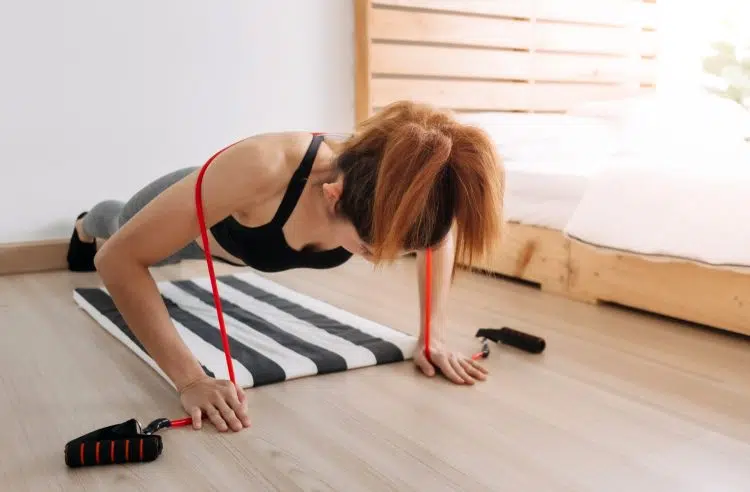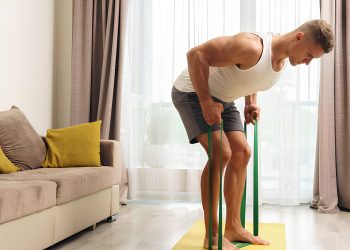Whether you work out at home, are traveling, or just need a break from lifting weights, resistance bands are a great option. You can replicate most popular strength training exercises with resistance bands, and research published on PubMed suggests that resistance band training is an effective way to build muscle and strength (1).
As well as being one of the most convenient workout methods, resistance bands are also easy on your joints. That’s because there is no moment of inertia to overcome, meaning the load gradually increases as you extend your limbs.
Resistance bands are also very safe. With no weights to drop, you can train your muscles to failure without fear of getting crushed by a barbell or dumbbell.
Of course, even the best workout methods have drawbacks, and resistance bands are no different. The disadvantages of resistance band training include:
Difficulty quantifying loads: While resistance bands are usually rated as light, medium, or heavy, it’s impossible to know how much weight you are lifting. This can make it hard to track your progress accurately.
Variable resistance: Resistance band tension increases significantly as the band is stretched. Because of this, it’s usually impossible to maintain consistent muscle tension. As such, some exercises may be too easy when the band is slack but too hard when it’s tight.
Level Up Your Fitness: Join our 💪 strong community in Fitness Volt Newsletter. Get daily inspiration, expert-backed workouts, nutrition tips, the latest in strength sports, and the support you need to reach your goals. Subscribe for free!
Wear and tear: Unfortunately, even the best resistance bands eventually degrade, wear out, and snap. More often than not, most breakages occur during a workout, which could bring your training to an abrupt end. Top tip: Make sure you’ve always got spares on hand!
Despite these drawbacks, resistance band training is still an excellent alternative to conventional weight training. In this article, I’ll share the best five resistance band exercises I have learned as a 30-year veteran personal trainer.
The 5 Resistance Band Exercises for a Full-Body Workout
You can use bands to replicate almost all barbell, dumbbell, or resistance machine exercises. In addition, there are many exercises that are unique to resistance band training. All this choice can be overwhelming and leave you wondering which exercises are actually worth your time and effort.
I’ve been training with resistance bands for over 30 years. Based on my experience, these are the only five resistance band exercises you need for a full-body workout.
1. Resistance Band Spanish Squat
Target muscles: Quadriceps, gluteus maximus, hamstrings.
I believe that every good workout should include some form of squats, even if you are training with resistance bands! The Spanish squat is a very knee-friendly exercise that will also crush your quads. Think of it as a squat/leg-extension hybrid.
Steps:
- Attach a loop-type resistance band to a knee-high anchor.
- Stand inside the band and place it behind your knees. Step back to put plenty of tension on the band. Stand with your feet about hip-width apart.
- Keeping your shins vertical, sit back, bend your legs, and squat down until your thighs are parallel to the floor. Maintain an upright torso throughout.
- Stand back up and then fully lock your knees against the tension provided by the band.
- Continue for the prescribed number of reps.
Tips:
- Experiment with a narrow, medium, and wide stance to see which you prefer.
- Use a broad, medium to strong resistance band. Also, check that your anchor is sturdy enough to support your weight.
- Make this exercise more challenging by holding a kettlebell or dumbbell:
2. Kneeling Band Hip Thrust
Target muscles: Gluteus maximus, hamstrings, quadriceps.
This is one of my all-time favorite glute exercises! In fact, I often prescribe this movement even if my clients have access to weights or machines. As well as being an amazing booty builder, this exercise will do wonders for your knee mobility. It’s also very low-back friendly.
Steps:
- Attach a loop-type resistance band to a knee-high anchor.
- Kneel inside the band with your back to the anchor and the band around your waist.
- Shuffle forward to tension the band.
- Sit back and lower your butt to your heels.
- Drive your hips forward and up until your thighs are vertical, and your glutes are fully engaged.
- Sit back on your heels and repeat.
Tips:
- Sit back slowly and then explode back up to maximize muscle engagement and avoid jarring your knees.
- Modify your range of motion according to your mobility and knee health. You don’t have to sit fully on your heels for this exercise to be effective.
- You can also kneeling band hip thrusts while holding a chair or bench for support. This can be useful when training with a strong band:
3. Resistance Band Push-Up
Target muscles: Pectoralis major, triceps, deltoids, core.
Push-ups are probably the most popular and widely performed exercise on the planet. From elite athletes to soldiers to school kids, just about everyone who works out does push-ups. Adding a band makes this great exercise even better, and you’ll love how it strengthens and tones your upper body.
Steps:
- Loop your resistance band around your upper back.
- Kneel down and adopt the push-up position. The band should be between your hands and the floor.
- Your arms should be straight and core braced.
- Bend your arms and lower your chest to the floor.
- Extend your arms and repeat.
Tips:
Level Up Your Fitness: Join our 💪 strong community in Fitness Volt Newsletter. Get daily inspiration, expert-backed workouts, nutrition tips, the latest in strength sports, and the support you need to reach your goals. Subscribe for free!
- Do this exercise with a handled or loop-type band as preferred.
- Bend your legs and rest on your knees to make this exercise easier.
- Place your hands on weight plates or yoga blocks to increase your range of motion and make this exercise harder.
4. Resistance Band Lat Pulldown
Target muscles: Latissimus dorsi, trapezius, rhomboids, deltoids, biceps.
While pull-ups and chin-ups are arguably the most low-tech way to train your upper back, these demanding exercises may be too challenging for some people. Resistance band lat pulldowns are much more accessible, and you don’t need a beam, bar, or branch to hang from to do them, so they’re ideal for home exercisers, too.
Steps:
- Attach the center of your band to a high anchor point, e.g., using a door anchor.
- Hold the handles, take 1-2 steps back, and kneel down.
- Lean forward so your body is in line with the band.
- Leading with your elbows, bend your arms, and pull your hands down to your shoulders. Make sure you squeeze your scapulae down and back.
- Extend your arms and repeat.
Tips:
- You can also do resistance band lat pulldowns with one arm at a time or using an alternating arm action.
- Kneel on a foam pad, exercise mat, or folded towel for comfort.
- No suitable high anchor? You can also do this exercise while lying on your front. This increases upper and lower back engagement.
5. Resistance Band Curl and Overhead Press
Target muscles: Biceps, deltoids, triceps.
My final resistance band exercise for full-body workouts is a twofer that combines a pair of well-known movements – biceps curls and overhead presses. Working your biceps, shoulders, and triceps, this is a great time-saving exercise that provides a challenging end to your workout.
Steps:
- Stand on your band with your feet about shoulder-width apart. Hold one end in each hand, arms by your sides. Pull your shoulders down and back, and brace your core.
- Bend your elbows and curl your hands up to your shoulders.
- Next, press your hands up above your head.
- Lower your hands to your shoulders and then your sides, and repeat.
Tips:
- Widen your stance to stretch the band more and make this exercise more challenging.
- You can also do this exercise with an alternating arm action.
- Get an even more comprehensive workout by adding a squat to your curl and press exercise:
Related: 10 Strength Coach-Approved Resistance Band Exercises You’ll Wish You’d Known About Sooner
FAQs
Do you have a question about these resistance band exercises? No problem, because I’ve got the answers! Need more info? Drop me a line in the comments section below, and I’ll reply ASAP.
1. How often should I do these exercises?
I recommend full-body strength training 2-3 times per week on non-consecutive days, e.g., Monday and Thursday, or Monday, Wednesday, and Friday. This provides the ideal balance between training and recovery.
While working out more often may seem like it would produce better results, it is usually counterproductive. It’s important to remember that your muscles only adapt and get stronger between workouts.
2. How many reps and sets should I do of these exercises?
Rather than worry about your precise rep range, simply continue each set until your muscles start to fatigue and approach failure. Recent studies suggest that proximity to failure is much more important than the number of reps you perform (2).
That said, maximal strength is best achieved with low reps (five or fewer) and very heavy loads. However, that’s not usually practical with resistance bands.
Regarding sets, most people will get good results from 3-4 per exercise. If you feel you need to do more than that, you are probably resting too long between sets or not getting close enough to failure.
3. Which are better – loop or handled bands?
This is not an easy question to answer because both types have advantages and drawbacks, and the best option will depend on your preferences and goals. For example, loop-type bands are usually more heavy-duty and better for leg exercises. However, bands with handles often work best for upper-body training.
Personally, I use both, and having loop and handled bands means I can do a wide range of exercises, choosing the best tool for the job. That said, bands with handles are generally more comfortable to hold. If your budget allows, I recommend buying a few of both types so you can enjoy the best of both worlds.
Closing Thoughts
I’ve always been an exercise minimalist, looking to achieve the best possible results with the least amount of training time and effort. That’s not because I’m lazy! Rather, it’s because working out is usually a means to an end, done as preparation for some kind of athletic event.
Also, as a busy personal trainer, I don’t always have a lot of time for my own workouts. Instead, I spend my time helping others to achieve their health and fitness goals. Consequently, I often have to work out on the go, which usually means home workouts. While I do have some weights at home, my favorite training method is resistance bands.
The exercises in this article provide a lot of bang for your buck and deliver a full-body workout in 30 minutes or less. They’re also ideal for travelers or anyone without access to a well-equipped gym.
So, rather than miss workouts because you can’t make it to the gym, grab some bands and pump rubber instead. At the very least, you’ll maintain your gains, but, more likely, you’ll develop your fitness and strength even further.
Related: Full-Body Resistance Band Workout for Home Exercisers
References:
- Andersen V, Prieske O, Stien N, Cumming K, Solstad TEJ, Paulsen G, van den Tillaar R, Pedersen H, Saeterbakken AH. Comparing the effects of variable and traditional resistance training on maximal strength and muscle power in healthy adults: A systematic review and meta-analysis. J Sci Med Sport. 2022 Dec;25(12):1023-1032. doi: 10.1016/j.jsams.2022.08.009. Epub 2022 Aug 28. PMID: 36130847.
- Grgic J, Schoenfeld BJ, Orazem J, Sabol F. Effects of resistance training performed to repetition failure or non-failure on muscular strength and hypertrophy: A systematic review and meta-analysis. J Sport Health Sci. 2022 Mar;11(2):202-211. doi: 10.1016/j.jshs.2021.01.007. Epub 2021 Jan 23. PMID: 33497853; PMCID: PMC9068575.









